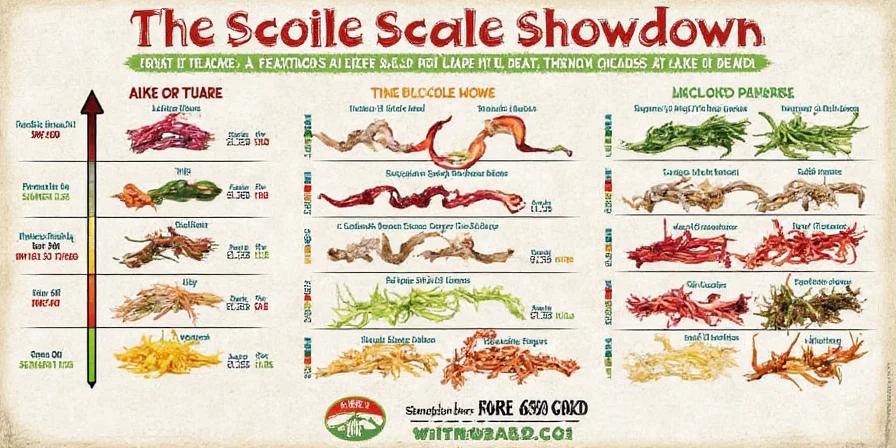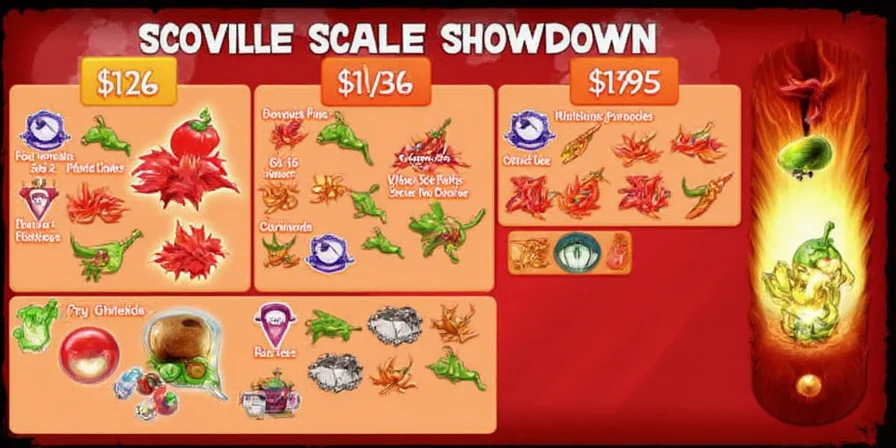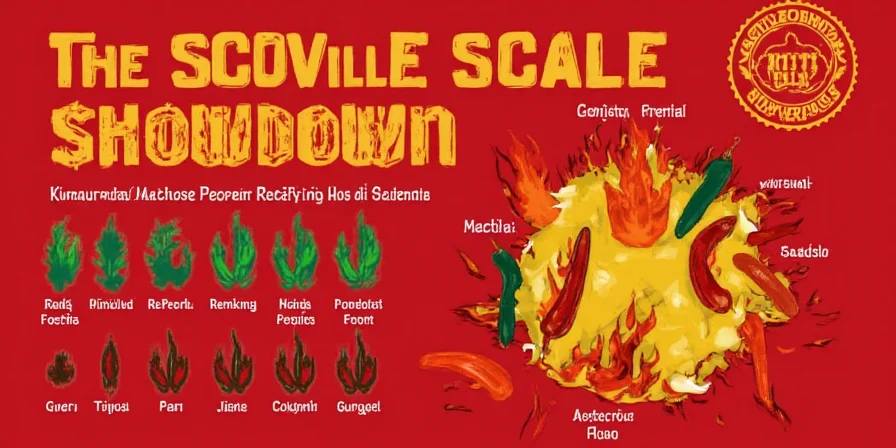The Scoville Scale measures chili pepper heat intensity in Scoville Heat Units (SHU), with 0 SHU for bell peppers and up to 2.2 million SHU for the Carolina Reaper. This complete reference chart answers your immediate question about pepper heat levels and provides essential safety guidance:
| Pepper Variety | Scoville Heat Units | Real-World Application |
|---|---|---|
| Bell Pepper | 0 SHU | Raw consumption, stuffed dishes, color contrast |
| Jalapeño | 2,500–8,000 SHU | Salsas, pickled preparations, moderate heat infusions |
| Habanero | 100,000–350,000 SHU | Tropical salsas, craft hot sauces, controlled heat layers |
| Ghost Pepper (Bhut Jolokia) | 855,000–1,041,427 SHU | Competition sauces, medicinal extracts, industrial applications |
| Carolina Reaper | 1,400,000–2,200,000 SHU | Record-breaking challenges, pharmaceutical research, defense products |

What Is the Scoville Scale and How Does It Work?
The Scoville Scale, developed by pharmacist Wilbur Scoville in 1912, measures chili pepper heat through capsaicin concentration. Modern testing uses high-performance liquid chromatography (HPLC) to precisely quantify capsaicinoids, then converts results to Scoville Heat Units (SHU). One SHU equals the dilution factor where heat becomes undetectable - meaning a 5,000 SHU jalapeño requires 5,000 parts water to neutralize its heat. This scientific measurement system transforms kitchen uncertainty into precise culinary control.

Critical Safety Protocols: How to Handle Extreme Peppers Safely
Professional handling requires immediate implementation of these evidence-based protocols when working with peppers over 50,000 SHU:
- Essential barrier protection: Nitrile gloves (not latex) are mandatory. Double-gloving required for Ghost Pepper and above
- Emergency relief: For skin exposure, use full-fat dairy followed by baking soda paste. For eyes, flush with saline for 15 minutes
- Heat mitigation: 1/4 teaspoon of habanero puree can overwhelm a dish. Always start with minimal amounts
- Myth correction: Alcohol spreads capsaicin - use dairy fats which contain casein to bind and remove capsaicin molecules

Why Do Identical Peppers Have Different Heat Levels?
Natural variation stems from soil composition, climate stressors, and ripeness. A single habanero plant may produce peppers ranging from 100,000 to 350,000 SHU. Commercial producers mitigate this through controlled environments and batch blending. Ripeness affects color but not necessarily heat - some green habaneros exceed ripe red variants in SHU measurements.

Innovative Applications Beyond Cooking
Capsaicin's biochemical properties enable groundbreaking implementations:
- Pharmaceutical development: 8% capsaicin patches show 30-50% pain reduction for neuropathic conditions
- Wildlife management: Non-lethal deterrents protect crops while avoiding ecological disruption
- Material science: Self-cleaning surfaces using capsaicin derivatives repel insects without toxicity

Debunking Popular Capsaicin Misconceptions
- Myth: Heat tolerance indicates physical fitness
Reality: Genetic variation in TRPV1 receptors determines sensitivity - unrelated to health metrics - Myth: Cooking eliminates capsaicin heat
Reality: Capsaicin remains stable up to 160°F (71°C) - prolonged cooking only redistributes heat - Myth: Color indicates heat level
Reality: Ripeness stage affects color but not necessarily heat intensity
Quick Reference: Top Pepper Heat Questions Answered
How hot is a habanero compared to jalapeño?
Habaneros (100,000-350,000 SHU) are 12-40 times hotter than jalapeños (2,500-8,000 SHU). One habanero equals approximately 20-40 jalapeños in heat intensity.
What's the hottest edible pepper in 2025?
The Carolina Reaper remains the hottest officially recognized pepper at 1.4-2.2 million SHU, though Pepper X and Dragon's Breath claim higher unofficial measurements.
Does capsaicin tolerance build permanently?
Temporary desensitization occurs through TRPV1 receptor depletion, but resets after 72 hours without exposure. No evidence supports permanent physiological changes.
How to measure pepper heat at home?
Professional HPLC testing is required for accurate SHU measurement. Home methods like dilution tests are unreliable due to human taste variation and safety risks.











 浙公网安备
33010002000092号
浙公网安备
33010002000092号 浙B2-20120091-4
浙B2-20120091-4